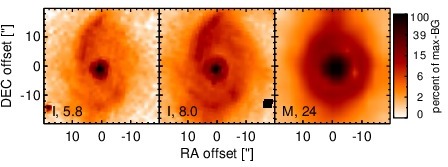Sasmirala Individual Information for NGC 6890
Description
NGC 6890 is a low-inclination grand-design spiral galaxy at a redshift of z = 0.0081(D ~ 33.8 Mpc) with a Sy 1.9/2 nucleus [phillips_nearby_1983, storchi-bergmann_stellar_1990]. The nucleus is detected but unresolved at arcsecond resolution at radio wavelengths [ulvestad_radio_1989, morganti_radio_1999]. After its detection with IRAS, NGC 6890 was followed up in the MIR with Spitzer/IRAC, IRS and MIPS. The corresponding IRAC and MIPS images show a dominant compact nucleus embedded within faint spiral-like host emission. Our nuclear IRAC 5.8 and 8.0μm photometry is significantly lower than the values published by [gallimore_infrared_2010] but agree with the Spitzer/IRS mapping-mode post-BCD spectrum. The latter suffers from low S/N but indicates weak silicate 10 and 18 μm emission, weak PAH features, and a red spectral slope in νFν-space (see also [buchanan_spitzer_2006, tommasin_spitzer_2008, tommasin_spitzer-irs_2010, wu_spitzer/irs_2009, gallimore_infrared_2010]). Thus, the arcsecond-scale MIR SED indicates unobscured AGN emission with minor star-formation contribution. The nuclear region of NGC 6890 was observed with T-ReCS in the broad N filter in 2004 [videla_nuclear_2013] and an apparently elongated nucleus without further host emission was detected (FWHM(major axis)~ 0.42arcsec ~ 68 pc; PA~ 102∘). However, at least a second epoch of MIR subarcsecond imaging is required to confirm this elongation. Our nuclear photometry is consistent with the value published by [videla_nuclear_2013] and also marginally consistent with the Spitzer spectrophotometry (~ 18% lower). Therefore, we use the latter to compute the nuclear 12 μm continuum emission estimate.
- [buchanan_spitzer_2006] Catherine L. Buchanan, Jack F. Gallimore, Christopher P. O'Dea, Stefi A. Baum, David J. Axon, Andrew Robinson, Moshe Elitzur, and Martin Elvis. Spitzer IRS spectra of a large sample of seyfert galaxies: A variety of infrared spectral energy distributions in the local active galactic nucleus population . AJ , 132 pp. 401–419, July 2006.
- [gallimore_infrared_2010] J. F. Gallimore, A. Yzaguirre, J. Jakoboski, M. J. Stevenosky, D. J. Axon, S. A. Baum, C. L. Buchanan, M. Elitzur, M. Elvis, C. P. O'Dea, and A. Robinson. Infrared spectral energy distributions of seyfert galaxies: Spitzer space telescope observations of the 12 μm sample of active galaxies . ApJS , 187 pp. 172–211, March 2010.
- [morganti_radio_1999] R. Morganti, Z. I. Tsvetanov, J. Gallimore, and M. G. Allen. Radio continuum morphology of southern seyfert galaxies . A&AS , 137 pp. 457–471, June 1999.
- [phillips_nearby_1983] M. M. Phillips, P. A. Charles, and J. A. Baldwin. Nearby galaxies with seyfert-like nuclei . ApJ , 266 pp. 485–501, March 1983.
- [storchi-bergmann_stellar_1990] T. Storchi-Bergmann, E. Bica, and M. G. Pastoriza. The stellar population and emitting gas in the inner 2-5-KPC for a sample of nine SEYFERT-2 galaxies . MNRAS , 245 pp. 749, August 1990.
- [tommasin_spitzer-irs_2010] Silvia Tommasin, Luigi Spinoglio, Matthew A. Malkan, and Giovanni Fazio. Spitzer-IRS high-resolution spectroscopy of the 12 μm seyfert galaxies. II. results for the complete data set . ApJ , 709 pp. 1257–1283, February 2010.
- [tommasin_spitzer_2008] Silvia Tommasin, Luigi Spinoglio, Matthew A. Malkan, Howard Smith, Eduardo González-Alfonso, and Vassilis Charmandaris. Spitzer IRS high-resolution spectroscopy of the 12 μm seyfert galaxies. i. first results . ApJ , 676 pp. 836–856, April 2008.
- [ulvestad_radio_1989] James S. Ulvestad and Andrew S. Wilson. Radio structures of seyfert galaxies. VII - extension of a distance-limited sample . ApJ , 343 pp. 659–671, August 1989.
- [videla_nuclear_2013] Liza Videla, Paulina Lira, Heather Andrews, Almudena Alonso-Herrero, David M. Alexander, and Martin Ward. Nuclear infrared spectral energy distribution of type II active galactic nuclei . ApJS , 204 pp. 23, February 2013.
- [wu_spitzer/irs_2009] Yanling Wu, Vassilis Charmandaris, Jiasheng Huang, Luigi Spinoglio, and Silvia Tommasin. Spitzer/IRS 5-35 μm low-resolution spectroscopy of the 12 μm seyfert sample . ApJ , 701 pp. 658–676, August 2009.
Images

Optical image (DSS, red filter). Displayed are the central 4 arcmin with North being up and East to the left. The colour scaling is linear with white corresponding to the median background (BG) and black to the 0.01% pixels with the highest intensity.

Spitzer MIR images. Displayed are the inner 40 arcsec with North being up and East to the left. The colour scaling is logarithmic with white corresponding to median BG and black to the 0.1% pixels with the highest intensity. The label in the bottom left states instrument and central wavelength of the filter in micron (I: IRAC, M: MIPS).

Subarcsecond-resolution MIR images sorted by increasing filter central wavelength. Displayed are the inner 4 arcsec with North being up and East to the left. The colour scaling is logarithmic with white corresponding to median BG and black to the 75% of the highest intensity of all images in units of sig_bg. The inset image (where present; either bottom or top right) shows the central arcsecond of the PSF from the calibrator star, scaled to match the science target. The labels in the bottom left state instrument and filter names (C: COMICS, M: Michelle, T: T-ReCS, V: VISIR).
SEDs


MIR SED. The description of the symbols in all the SED plots (where present) is the following: Grey crosses and solid lines mark the Spitzer/IRAC, MIPS and IRS data. The colour coding of the other symbols is as follows: green for COMICS, magenta for Michelle, blue for T-ReCS and red for VISIR data. Darker-coloured solid lines mark spectra of the corresponding instrument. The black filled circles mark the nuclear 12 and 18 micron continuum emission estimate from the data (where present). The ticks on the top axis mark positions of common MIR emission lines, while the light grey horizontal bars mark wavelength ranges affected by the silicate 10 and 18 micron features.